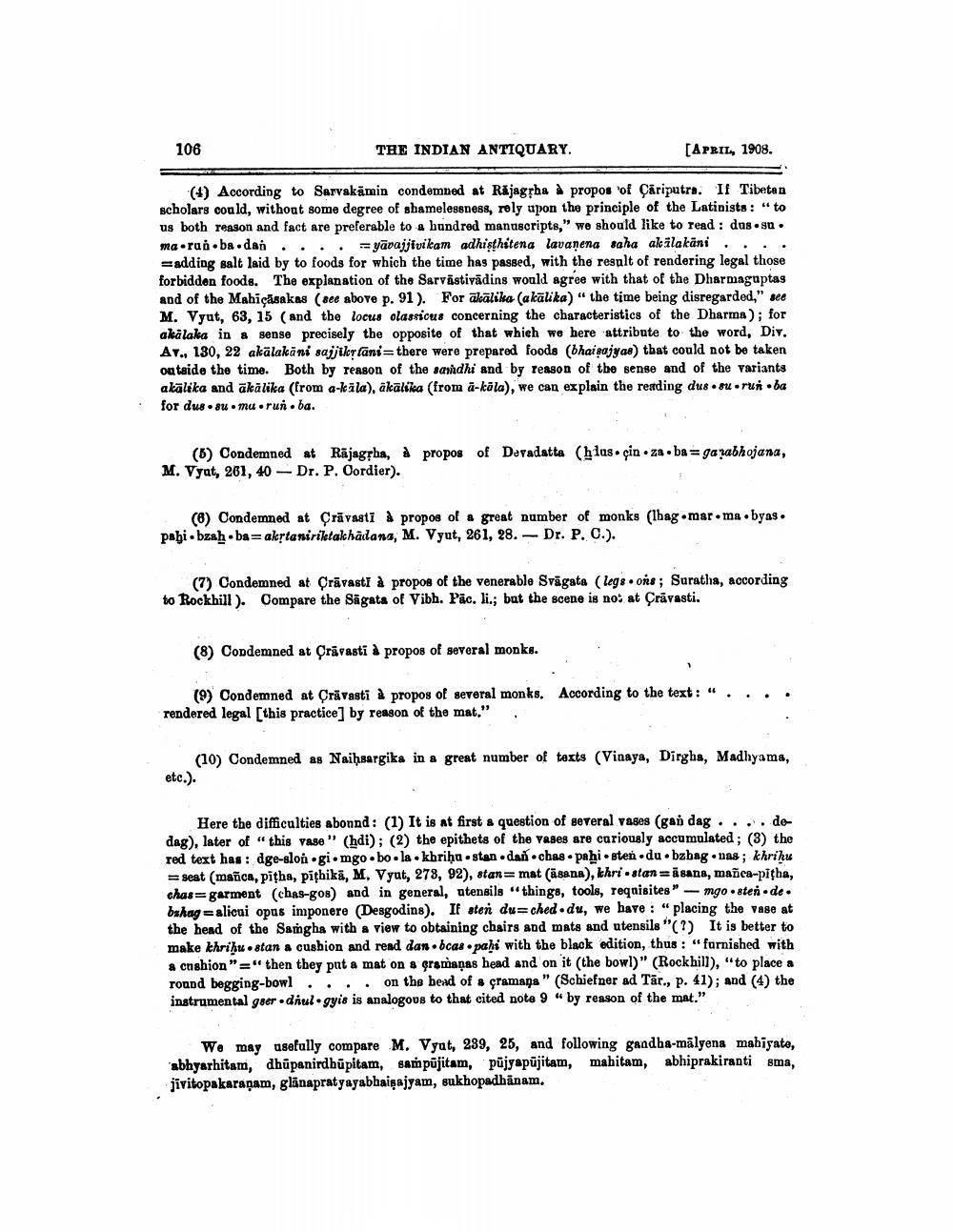________________
106
THE INDIAN ANTIQUARY.
[APRIL, 1908.
(4) According to Sarvakamin condemned at Rajagṛha à propos of Cariputra. If Tibetan scholars could, without some degree of shamelessness, rely upon the principle of the Latinists: "to us both reason and fact are preferable to a hundred manuscripts," we should like to read: dus.su. ma ran.ba.dan . -yavajjivikam adhisthitena lavanena saha akalakani..
adding salt laid by to foods for which the time has passed, with the result of rendering legal those forbidden foods. The explanation of the Sarvästivadins would agree with that of the Dharmaguptas and of the Mahiçäsakas (see above p. 91). For akalika (akalika) " the time being disregarded," see M. Vyut, 63, 15 (and the locus olassicus concerning the characteristics of the Dharma); for akalaka in a sense precisely the opposite of that which we here attribute to the word, Div. Av., 130, 22 akalakāni sajjikṛlani- there were prepared foods (bhaisajyas) that could not be taken outside the time. Both by reason of the samdhi and by reason of the sense and of the variants akālika and ākālika (from a-kāla), ākālika (from ā-kāla), we can explain the reading dus.su.run .ba for dus sumu.run.ba..
•
(5) Condemned at Rajagṛha, à propos of Devadatta (hius. çin za M. Vyat, 261, 40-Dr. P. Cordier).
za ba ganabhojana,
(6) Condemned at Cravasti à propos of a great number of monks (lhag.mar.ma.byas. pahi.bzah ba akṛtaniriktakhadana, M. Vyut, 261, 28. Dr. P. C.).
(7) Condemned at Cravasti à propos of the venerable Svagata (legs ons; Suratha, according to Rockhill). Compare the Sagata of Vibh. Päc. li.; but the scene is not at Cravasti.
(8) Condemned at Cravasti à propos of several monks.
(9) Condemned at Cravasti à propos of several monks. According to the text: " rendered legal [this practice] by reason of the mat."
...
(10) Condemned as Naiḥsargika in a great number of texts (Vinaya, Dirgha, Madhyama, etc.).
•
Here the difficulties abonnd: (1) It is at first a question of several vases (gan dag. . . . dedag), later of "this vase" (hdi); (2) the epithets of the vases are curiously accumulated; (3) the red text has dge-slongi.mgo bola khriḥu stan. dan chas pahi sten du. bzhag nas; khrihu =seat (mañca, pitha, pithika, M, Vyut, 278, 92), stan= mat (asana), khri stan asana, mañca-pitha, chas garment (chas-gos) and in general, utensils "things, tools, requisites" mgo⚫sten.de. bahagalicui opus imponere (Desgodins). If sten du ched du, we have: "placing the vase at the head of the Samgha with a view to obtaining chairs and mats and utensils "(?) It is better to make thriḥustan a cushion and read dan bcas pahi with the black edition, thus: "furnished with a cushion"=" then they put a mat on a çramanas head and on it (the bowl)" (Rockhill), "to place a round begging-bowl.... on the head of a çramana" (Schiefner ad Tar., p. 41); and (4) the instrumental geer dhul gyis is analogous to that cited note 9 "by reason of the mat."
We may usefully compare M. Vyut, 239, 25, and following gandha-malyena mahiyate, abhyarhitam, dhupanirdhūpitam, sampujitam, pūjyapujitam, mahitam, abhiprakiranti sma, jivitopakaranam, glänapratyayabhaiṣajyam, sukhopadhānam.




